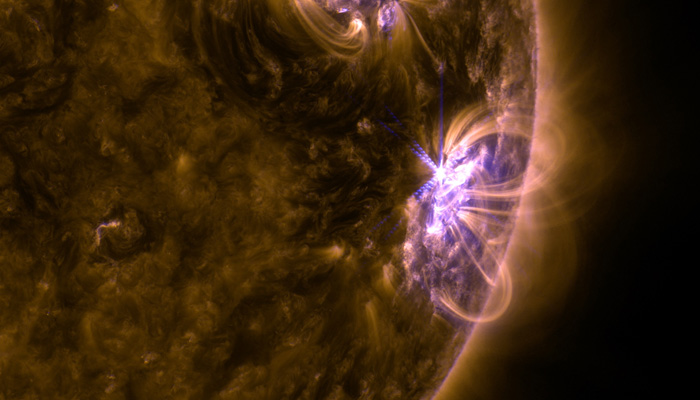Why some parts of US suffered strong radio blackouts
Giant sunspot, AR3354, was first seen on June 27 and increased in size rapidly to a size about 10 times larger than Earth
July 05, 2023

As it was predicted that there will solar flares affecting communications signals on Earth amid rising activity on the sun's surface, National Oceanic and Atmospheric Administration's (NOAA) Space Weather Prediction Center stated that a "strong radio blackout" occurred in some parts of the US recently.
“The flare came from a large and complex region denoted as sunspot group 3354,” NOAA said, adding that it led to a "temporary degradation or complete loss of High Frequency (HF) radio signals on some of the sunlit sides of Earth."
The giant sunspot, named AR3354, was first spotted on June 27 and increased in size rapidly within a span of two days to a size about 10 times larger than Earth, raising concerns among space weather scientists, according to the Independent.
Nasa stated: "Sunspots are areas that appear dark on the surface of the Sun. They appear dark because they are cooler than other parts of the Sun's surface."
"The magnetic field lines near sunspots cause explosions as they reorganise, causing solar flares. It releases a lot of radiation into space. The intense intense explosion, releases radiation that can interfere with our radio communications here on Earth," said Nasa.
Apart from this, another concern is solar storm events in which huge amounts of coronal mass ejection (CME) take place, travelling from space to hit the Earth's magnetic field.
Their effects could spark geomagnetic storms. As a result, the satellites, communication, internet connectivity, and GPS could be disrupted or damaged. It could also cause power grid failures.
Therefore, scientists believe as the sun becomes more active, more sunspots, solar flares and CMEs are expected to erupt.
With the help of tracking sunspots, scientists can monitor the solar cycle and its progress toward maximum activity.
It was predicted by a panel of scientists in 2020 that the sun's current cycle would reach its maximum in 2025 with a peak of roughly 115 sunspots.
However, the number of sunspots outstripped the predictions and in January 140 sunspots, were seen, when no more than 92 were predicted, according to a database of the NOAA. In May, there were 140 sunspots.
The solar storm Sunday led to brief radio blackouts lasting for about 30 minutes in the western US and parts of the eastern Pacific Ocean, according to NOAA.
The flare peaked in intensity at 7:14pm ET on 2 July, Nasa’s Solar Dynamics Observatory said in a statement.
Experts noted that if the flare had launched along with it fast-moving charged particles, in what’s called a CME it might have led to an even larger radio blackout.
The sunspot AR3354 has not contracted and may still emanate more solar flares in days to come.
This sunspot first produced a minor M-class flare on 29 June and, after a brief period of calm, unleashed an X-class flare — the most powerful category of solar flare the Sun can belch out — aimed directly at Earth.
"When this week began, sunspot AR3354 didn’t exist. Now it is 10 times wider than Earth and still growing. The sunspot burst into view on June 27th, breaching the surface of the sun, then blossoming into a giant over the next 48 hours," noted Spaceweather.com.









